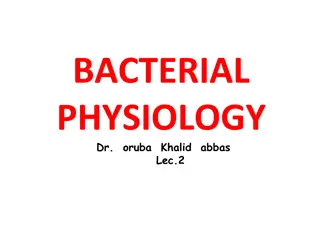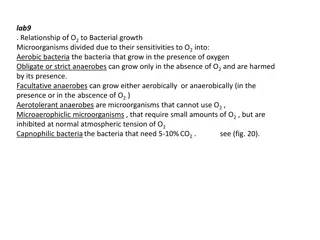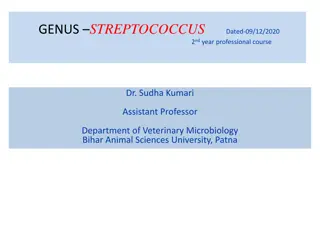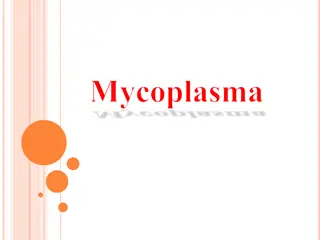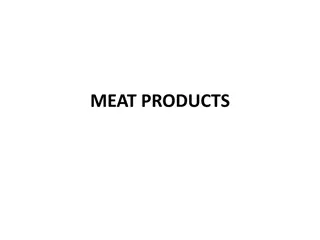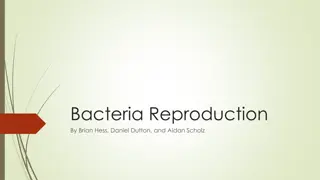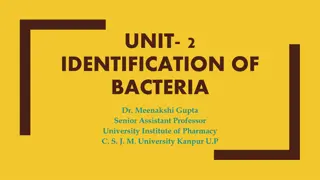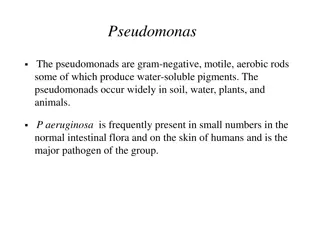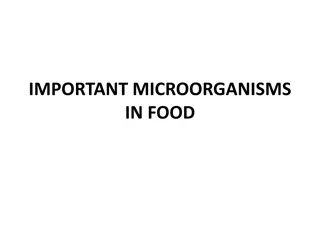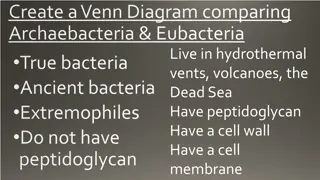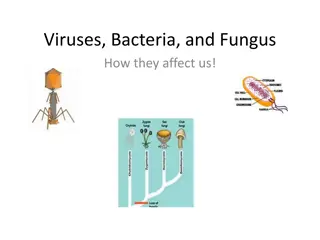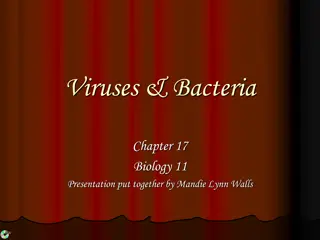Understanding Bacteria Cultures and Growth: Key Concepts and Practical Tips
Scientists culture bacteria to study them effectively. Differentiating between bacteria and viruses, maintaining precautions when handling bacteria cultures, and controlling their spread are vital. Tasks like watching relevant videos, self-assessments, steps for growing useful microorganisms provide practical insights. By following proper procedures like sterilization, handling, and temperature control, researchers can ensure accurate results and prevent contamination in bacterial cultures.
Download Presentation

Please find below an Image/Link to download the presentation.
The content on the website is provided AS IS for your information and personal use only. It may not be sold, licensed, or shared on other websites without obtaining consent from the author. Download presentation by click this link. If you encounter any issues during the download, it is possible that the publisher has removed the file from their server.
E N D
Presentation Transcript
Growing bacteria Do now activity: 1. How do bacteria and viruses differ from on another? 2. Identify some precautions you might use when handling bacteria cultures. 3. Describe how you might control the spread of bacteria
Progress indicators GOOD PROGRESS: Understand why cultures of bacteria are kept at lower temperatures in schools compared to industry Describe how to grow an uncontaminated culture of bacteria in the lab OUTSTANDING PROGRESS: Calculate the number of bacteria in a population
In order to find out more about microorganisms, scientists need to culture them. This means they are grown in very large numbers so that scientists can see all of the bacteria (the colony) as a whole. Separate colonies of bacteria
Task: Watch the video and answer the following questions: 1. If bacteria are kept in a suitable medium, at what rate can they multiply? 2. What is this simple process of division called? 3. For what purposes might scientists want to produce cultures of bacteria? 4. What useful substances are found in the agar jelly? These substances help bacteria to grow. 5. What do you need to do before using the inoculating loop to spread the bacteria onto the agar plate? Why is this process important? 6. Why is the Petri dish loosely taped shut? 7. What is the temperature at which bacteria cultures are kept in a school lab? Why is this? https://www.youtube.com/watch?v=Uf8a7cCVjM4
Self-assessment: 1. 2. Binary fission 3. To test the effects of disinfectants or antibiotics on the growth/survival of bacteria 4. Carbohydrates, proteins, vitamins an minerals are all found in agar jelly. The bacteria need these substances in order to thrive, grow and reproduce. 5. Firstly the inoculating loop is sterilised using a Bunsen burner flame. This stops any unwanted bacteria from contaminating the culture. 6. The Petri dish is taped shut in order to prevent the bacteria culture from being contaminated 7. School labs keep bacteria cultures at 25 C, compared to industries which keep cultures at 37 C, as it is safer at a lower temperature. This means that the bacteria will not grow uncontrollably and develop into harmful pathogens which are bad for our health. Every 20 minutes
Growing useful microorganisms Step 1: Sterilise the inoculating loop by passing it through a Bunsen burner flame until it is red hot. Let it cool, do not put the loop down or blow on it to cool it Step 2: Dip the sterilised loop into the suspension of bacteria you would like to grow, use the loop to make zigzag streaks across the surface of the agar. Replace the lid on the dish as quickly as possible to avoid contamination. Step 3: Fix the lid of the Petri dish with tape to prevent microorganisms from the air contaminating the culture or microbes from the culture escaping. Do not seal all the way around the edge as oxygen will still need to enter so that bacteria can respire and grow. Step 4: The Petri dish should be labelled and stored upside down to stop condensation falling on the agar surface. The dish should be kept in an incubator set at 25 C.
Task: Using the key words below, complete the boxes to show the stages by which microorganisms are grown on agar plates Key word bank Sterilisation Inoculating loop Bunsen burner Beaker Nutrient broth (contains bacteria) Agar plate
Self-assessment: Sterilise the inoculating loop by passing it through a Bunsen burner flame until it is red hot. Let it cool, do not put the loop down or blow on it to cool it as this will recontaminate it Dip the sterilised inoculating loop into the beaker of nutrient broth containing the bacteria you would like to grow Use the inoculating loop to make zigzag streaks across the surface of the agar. Replace the lid on the dish as quickly as possible and fix with tape (but do not seal all the way around) so that bacteria can respire and grow.
Self-assess your work 1. a) Any two from: Method of sterilisation (e.g. use of autoclave / boiling water) Sterilisation to kill microorganisms Pass flask / innoculating loop through bunsen burner flamer Make sure all work is carried out near to a flame Minimise the time the bacteria is exposed to air (opening of flask / test-tube / petri dish) (2) b) Any two from: Temperature Type of nutrient Volume of solution Amount of bacteria added Concentration of nutrients (2)
Calculating bacterial growth Task: Watch the video, pausing when instructed, to carry out calculations related to the growth of bacteria on a Petri dish. https://www.youtube.com/watch?v=R6Uv__WJlmM
Calculating the number of bacteria in a population Worked example: The mean division time of bacteria is 30 minutes. Calculate how many bacteria will result from each individual bacterium after 8 hours. 1. How many times will the bacteria divide in 8 hours? If bacteria divide very 20 minutes they will divide 60/30 or twice every hour. If the colony grows for 9 hours, each of the initial bacteria will divide 8 x 2 or 16 times 2. Calculate the number of bacteria in the population Every time the bacteria divides, the population doubles, so we can find the number of bacteria using the following equation: 2number of divisions Bacteria at the end of the growth period Therefore, 1 x 216 = 1 x 65536 = 65 536 bacteria Bacteria at the beginning of the growth period = x
Measuring the impact of chemicals on bacteria growth Task: Using the calculation below, copy and complete this table to show the area of the clear zones. Radius= D/2 Area of a circle = Chemical Measured diameter (D) of clear circle (mm) Calculated radius of cleared circle (mm) Calculated surface area of clear circle (mm2) None 0.0 Disinfectant 1 7.0 Disinfectant 2 4.0 Disinfectant 3 12.0
Self-assessment: Chemical Measured diameter (D) of clear circle (mm) Calculated radius of cleared circle (mm) Calculated surface area of clear circle (mm2) None 0.0 7.0 0.0 3.5 0.0 38.5 Disinfectant 1 Disinfectant 2 4.0 2.0 12.6 Disinfectant 3 12.0 6.0 113.1
Plenary: What have you learnt this lesson? Summarise what you have learnt in 3 sentences!



